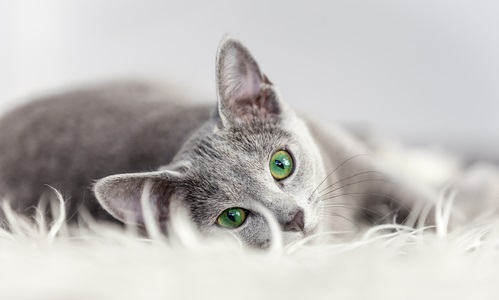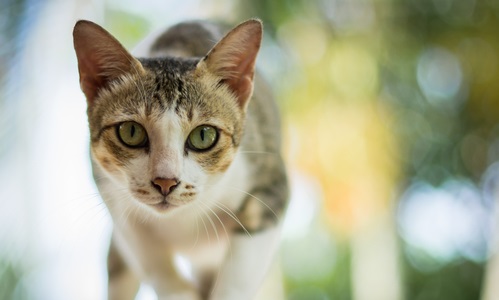Cat’s eyes aren’t clear and beautiful all the time. Sometimes, cats have unsightly discharge or accumulation of gunk.
Usually, this is nothing more than eye-boogers, but other times it can be a sign of infection or another serious health issue.
Don’t worry, everything you need to know about cat eye discharge in this article.
Read on to learn:
- What exactly is cat eye discharge?
- Cat eye discharge symptoms.
- When you should seek medical advice for your cat.
- How to care for your cat when he’s experiencing eye discharge.
- How to prevent eye discharge and other eye issues experienced by your cat.
What is Cat Eye Discharge?
The truth is, depending on your cat, you may have a different idea in mind of what discharge is then another cat owner.
This is because there can be a lot going on in a cat’s eye. Just like the human eye, cat eyes are complex organs.
Here are some things to keep in mind when considering what constitutes eye discharge and when you should be concerned:
- Don’t sweat the little stuff: This is a saying that will relieve your stress in many ways, but (strangely) it also makes a lot of sense when applied to cat eye discharge. This is because a little bit of eye discharge in cats is normally not a sign of anything serious. Ideally, a healthy eye would have no discharge, but a bit of clear discharge (even if it dries brown and crusty) isn’t always a cause for alarm. If you notice this in your cat, just keep an eye on it to make sure it doesn’t get worse.
- Some breeds are eye-booger prone: Yes that’s a mouthful. It’s also true. Some cat breeds such as Persians and Himalayans are known to accumulate boogers around their eyes. If you have a breed with a short nose and round eyes, consult your vet if you think their eye discharge is excessive.
- Cat eye discharge can be a sign of a major issue: While most of the time cat eye discharge is going to be nothing major, it can be a sign of an underlying acute or chronic health condition. It’s always better to be safe than sorry, so if you have any concern about your cat’s eyes, be sure to contact your vet. Read on to learn some of the symptoms of cat eye discharge and other things to watch out for.
Symptoms of Cat Eye Discharge
While cat eye discharge is a symptom and not a disease, there are symptoms that often go along with cat eye discharge. Sometimes, these symptoms are normal, other times, they’re a major cause for alarm.
Here are some of the symptoms you may see if your cat has eye discharge:
- Watery or tear-soaked eyes: Often times, eye discharge can be accompanied by a watery discharge, which is usually a tear-like liquid. One sign of this is water or tear-stained fur around your cat’s eyes. Other times, this can be a sign of a blocked tear duct. This tear-like substance can be watery and thin or thick.
- Eye-boogers and mucus: This is usually what people are referring to when they talk about cat eye discharge. This discharge can range from normal eye-boogers to a thick, mucus-like substance. As long as it doesn’t worsen, this is usually okay.
- Crusty eyes: A crusty substance around the eyes is a sign that eye discharge has dried. If it’s brown in color, it’s usually harmless. However, if there’s an excessive amount or it happens frequently, you should contact your vet.
- Red, swollen, or squinty eyes: Depending on the cause of the discharge, your cat can also show symptoms of inflamed and irritated eyes. This can be accompanied by swelling or excessive blinking or squinting.
 Seeing one or more of these symptoms isn’t necessarily a sign of something wrong. But, there are signs that will appear if it’s a serious acute or chronic health condition affecting your cat’s eyes.
Seeing one or more of these symptoms isn’t necessarily a sign of something wrong. But, there are signs that will appear if it’s a serious acute or chronic health condition affecting your cat’s eyes.
Thes symptoms are discussed in the section below.
When to Call Your Vet
As mentioned earlier in the article, there’s really no risk in calling your vet at the first sign of discharge. If it’s something harmless, at least you’ll be able to sleep easier.
So, here is a list of signs and symptoms your cat needs to see an animal healthcare professional.
Eye Discharge Continues for Many Days
If you notice some discharge on your cat’s eyes for a few days, it’s probably no big deal.
However, if it looks like it’s not going away after three or four days, you may think about bringing your cat to the vet.
This is because many minor causes of discharge, such as an acute dry eye reaction or a minor scratch, heal themselves naturally in just a few days.
Longer healing times indicate something more impactful is wrong. This is why it’s important to spend time with your cat and check on them daily. That way, you can spot problems before they get difficult to treat.
Eye Discharge Increases
As mentioned, a small amount of discharge is usually fine. But if you notice a lot of discharge or that the amount of discharge has increased, then it could be a sign of a more serious problem.
There’s no rule of how much discharge is too much. It all depends on your specific cat and his genetic makeup and other predispositions. This is another reason to perform regular check ups.
Once you know what is normal for your cat in terms of eye discharge, you’ll be able to recognize when it increases and becomes too much.
The Color or Consistency of the Discharge Changes
Although viral infections can cause a clear, mucusy discharge, normally clear discharge is no sign for concern. Yellow or green and sticky discharge, on the other hand, can be a sign of a serious acute (and possibly chronic) condition.
Yellow or green discharges are almost certainly a sign of a bacterial or fungal infection. Infections in the eye can be caused by a number of reasons, including trauma (such as a scratch), a prior upper-respiratory infection, or an autoimmune or other chronic condition that is weakening the immune system of your cat.
No matter what, if you notice discolored discharge, you need to make an appointment with your vet right away.
Other Symptoms Worsen
If your cat has an unusual amount of eye discharge and some of the symptoms mentioned earlier, it’s more likely that he is suffering from a condition that requires medical attention.
For example, excessive blinking and squinting alongside swollen or cloudy eyes can mean your cat has an injury or a physical object stuck in his eye.
If you notice other symptoms alongside eye discharge, take a closer look.
Behavioral Changes
This is often one of the most obvious signs of distress seen in pets. Let’s face it, as a pet owner you may not always detect a bit of extra redness or excessive eye boogers, but you certainly notice when your cat doesn’t play with his favorite toy or run to his dinner bowl like he usually does.
Other signs of behavioral change are ones mentioned above, such as squinting or pawing at their eyes excessively. But, there may be other illness-related behaviors too.
Coughing (a sign of respiratory infection), vomiting, sneezing, lethargy, decreased appetite, etc.
A bit of discharge or a slight cough separately may mean nothing. But together, you may want to take a closer look.
How to Care for Your Cat, When He’s Suffering From Eye Discharge
Pet owners are the compassionate type, so you probably want to get down to business and talk about how you can make your furry friend feel better!
The truth is, there’s usually no quick and easy fix if your cat has something wrong with his eye. The most important step you can take is calling your vet to set up an appointment.
If you think you know the cause of the discharge, for example, from allergens or irritants, take away the source of the allergens or irritants immediately.
Here are some other steps you can take:
- Wipe his eyes clean: Not every cat will be comfortable with this, and some may reward you for your troubles by giving you a nice scratch. But if your cat allows it, you can wipe his eyes clean using a moist cotton ball. Be sure to wipe from the corners out, and also use a fresh ball for every wipe. Doubly important is to use a fresh ball when moving to a new eye. In addition, wash your hands to avoid giving any more germs to your cat.
- Avoid other cats: This is important for a few reasons. First off, if your cat has the beginning stages of an infection, it’s important to keep him away from other cat’s germs that can wreak havoc on their weakened immune system. The other reason is to protect other cats from any germs your kitty may possess. Don’t worry, he’ll be all better and back to playing with his friends in no time.
- Don’t use over the counter medication: Sometimes, you may think you should rush to the pharmacy and get some eye drops or other medication. Unless you’re an animal health care professional or get explicit instructions from your vet, just don’t do this. You’re better off waiting for your vet’s advice, rather than giving your cat something he doesn’t need or shouldn’t have. If you’re really concerned about your cat, tell your vet it’s an emergency or take them to an emergency vet clinic.
- Keep an eye on your cat: Again, the most important thing you can do for the health of your cat is to perform regular checkups. This is doubly important if you begin suspecting a problem such as eye discharge. Not sure what to look for? Scroll back up and reread our section titled, “When to Call Your Vet”.
Recovery and Beyond
 So, whether your cat is facing an approaching recovery from eye issues, or you just want to prevent any eye issues from showing up in the first place, there a few things you can do to speed up the recovery process.
So, whether your cat is facing an approaching recovery from eye issues, or you just want to prevent any eye issues from showing up in the first place, there a few things you can do to speed up the recovery process.
A few recommendations mentioned above, such as avoiding other cats and cleaning your cat’s eyes are a good place to start, but there are some other extremely easy ones too.
In Summary
To reassure you that if your cat has discharge, most of the time he is going to be okay. So before you panic, pick up your phone to call your vet.
Sources:
- Brown, Jackie. “Cat Eye Discharge – What’s Normal and What’s Not.” Catster, 11 Jan. 2019, www.catster.com/cat-health-care/cat-eye-discharge-whats-normal-and-whats-not.
- “Cat Eye Discharge: A Comprehensive Guide.” Honest Paws, 17 Sept. 2018, www.honestpaws.com/blogs/pet-care/cat-eye-discharge.
- Vogelsang, Jessica. “Cat Eye Infections: Symptoms & Treatment.” Petfinder, www.petfinder.com/cats/cat-health/cat-eye-infections-symptoms-diagnosis-prognosis-and-treatment/.
- Wilson, Julia. “Cat Eye Discharge – Causes, Symptoms, & Treatment.” Cat World, Cat-World, 3 Feb. 2017, www.cat-world.com.au/eye-discharge-in-cats.html.




